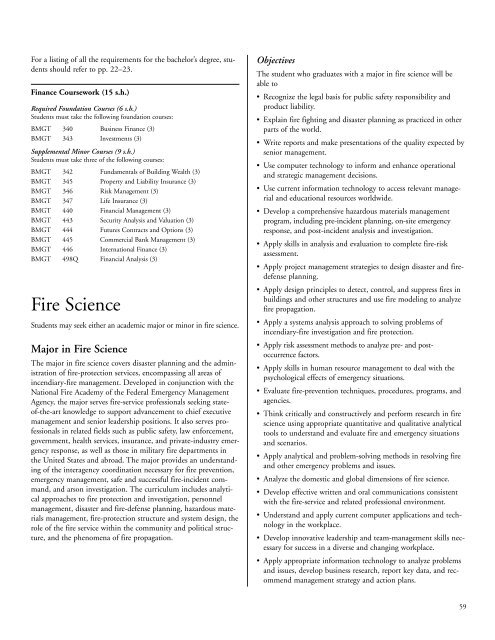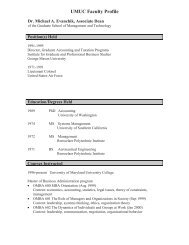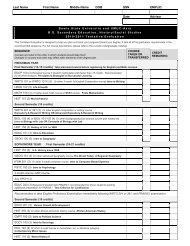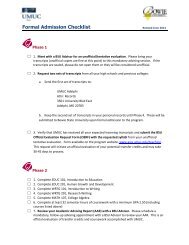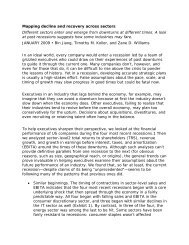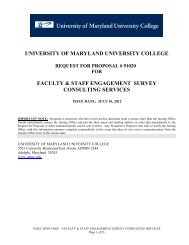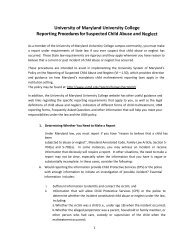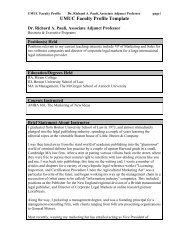1a. IntroSUS 2003 - University of Maryland University College
1a. IntroSUS 2003 - University of Maryland University College
1a. IntroSUS 2003 - University of Maryland University College
- No tags were found...
You also want an ePaper? Increase the reach of your titles
YUMPU automatically turns print PDFs into web optimized ePapers that Google loves.
For a listing <strong>of</strong> all the requirements for the bachelor’s degree, studentsshould refer to pp. 22–23.Finance Coursework (15 s.h.)Required Foundation Courses (6 s.h.)Students must take the following foundation courses:BMGT 340 Business Finance (3)BMGT 343 Investments (3)Supplemental Minor Courses (9 s.h.)Students must take three <strong>of</strong> the following courses:BMGT 342 Fundamentals <strong>of</strong> Building Wealth (3)BMGT 345 Property and Liability Insurance (3)BMGT 346 Risk Management (3)BMGT 347 Life Insurance (3)BMGT 440 Financial Management (3)BMGT 443 Security Analysis and Valuation (3)BMGT 444 Futures Contracts and Options (3)BMGT 445 Commercial Bank Management (3)BMGT 446 International Finance (3)BMGT 498Q Financial Analysis (3)Fire ScienceStudents may seek either an academic major or minor in fire science.Major in Fire ScienceThe major in fire science covers disaster planning and the administration<strong>of</strong> fire-protection services, encompassing all areas <strong>of</strong>incendiary-fire management. Developed in conjunction with theNational Fire Academy <strong>of</strong> the Federal Emergency ManagementAgency, the major serves fire-service pr<strong>of</strong>essionals seeking state<strong>of</strong>-the-artknowledge to support advancement to chief executivemanagement and senior leadership positions. It also serves pr<strong>of</strong>essionalsin related fields such as public safety, law enforcement,government, health services, insurance, and private-industry emergencyresponse, as well as those in military fire departments inthe United States and abroad. The major provides an understanding<strong>of</strong> the interagency coordination necessary for fire prevention,emergency management, safe and successful fire-incident command,and arson investigation. The curriculum includes analyticalapproaches to fire protection and investigation, personnelmanagement, disaster and fire-defense planning, hazardous materialsmanagement, fire-protection structure and system design, therole <strong>of</strong> the fire service within the community and political structure,and the phenomena <strong>of</strong> fire propagation.ObjectivesThe student who graduates with a major in fire science will beable to•Recognize the legal basis for public safety responsibility andproduct liability.•Explain fire fighting and disaster planning as practiced in otherparts <strong>of</strong> the world.•Write reports and make presentations <strong>of</strong> the quality expected bysenior management.•Use computer technology to inform and enhance operationaland strategic management decisions.•Use current information technology to access relevant managerialand educational resources worldwide.•Develop a comprehensive hazardous materials managementprogram, including pre-incident planning, on-site emergencyresponse, and post-incident analysis and investigation.•Apply skills in analysis and evaluation to complete fire-riskassessment.•Apply project management strategies to design disaster and firedefenseplanning.•Apply design principles to detect, control, and suppress fires inbuildings and other structures and use fire modeling to analyzefire propagation.•Apply a systems analysis approach to solving problems <strong>of</strong>incendiary-fire investigation and fire protection.•Apply risk assessment methods to analyze pre- and postoccurrencefactors.•Apply skills in human resource management to deal with thepsychological effects <strong>of</strong> emergency situations.•Evaluate fire-prevention techniques, procedures, programs, andagencies.• Think critically and constructively and perform research in firescience using appropriate quantitative and qualitative analyticaltools to understand and evaluate fire and emergency situationsand scenarios.•Apply analytical and problem-solving methods in resolving fireand other emergency problems and issues.•Analyze the domestic and global dimensions <strong>of</strong> fire science.•Develop effective written and oral communications consistentwith the fire-service and related pr<strong>of</strong>essional environment.•Understand and apply current computer applications and technologyin the workplace.•Develop innovative leadership and team-management skills necessaryfor success in a diverse and changing workplace.•Apply appropriate information technology to analyze problemsand issues, develop business research, report key data, and recommendmanagement strategy and action plans.59


